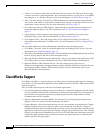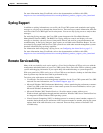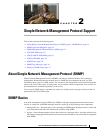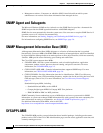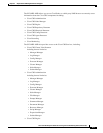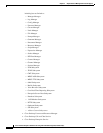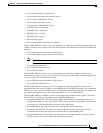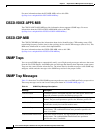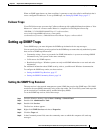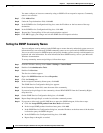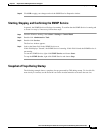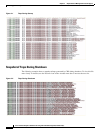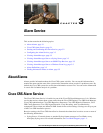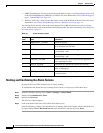
2-5
Cisco Customer Response Solutions Servicing and Troubleshooting Guide, Release 5.0(1)
Chapter 2 Simple Network Management Protocol Support
SYSAPPL-MIB
• Cisco Desktop IP Phone Agent Service
• Cisco Desktop Recording and Statistics Service
• Cisco Desktop VoIP Monitor Service
• Cisco Desktop Recording Service
• Cisco Desktop LDAP Monitor Service
• CRS SQL Server--Repository
• CRS SQL Server--Historical
• CRS SQL Server--Config
• CRS SQL Server--Agent
• Microsoft SQL Agent
• Microsoft Distributed Transaction Coordinator
The SYSAPPL-MIB also allows you to use CiscoWorks or a third-party Network Management System
(NMS) to remotely access information about these Unified CCX Standard and Unified CCX Enhanced
packages:
• Cisco CRS Recording and Statistics (RAS) Server
• Cisco CRS Telephony Agent Interface (TAI) Server
Note The TAI Server is also called the Cisco Desktop IP Phone Agent Service.
• Cisco CRS Enterprise Server
• Cisco CRS VoIP Monitor Server
• Cisco CRS Chat Server
The SYSAPPL-MIB also allows you to use CiscoWorks or a third-party NMS to remotely access
information about these services on an Unified CCX Call Statistics, Recording, and Monitoring Server,
or on an Unified CCX Call Monitoring Server:
• Cisco CRS Recording and Statistics (RAS) Server
• Cisco CRS VoIP Monitor Server
The SYSAPPL-MIB also allows you to use CiscoWorks or a third-party NMS to remotely access
information about the status of the SQL services MSSQLService and SQLServerAgent. For a standalone
CRS server (a server on which CRS but not Cisco Unified Communications Manager is installed), and
for a Database Expansion Server, this information appears as "Cisco CRS Database."
The SYSAPPL-MIB uses SNMP to organize and distribute the information that it gathers from your
network. The Cisco CRS system supports these SYSAPPL-MIB tables:
• SysApplInstallPkgTable—Provides installed application information, including manufacturer,
product name, product version, date installed, and location, which is a partial URL for accessing the
associated Cisco CRS Administration web page (when applicable)
• SysApplRunTable—Describes the application starting time and run-time status
• SysApplInstallElmtTable—Describes the individual application elements or the associated
executables that make up the applications defined in the SysApplInstallPkgTable
• SysApplElmtRunTable—Describes the processes that are currently running on the host system,
similar to the processes that the Windows Task Manager displays




